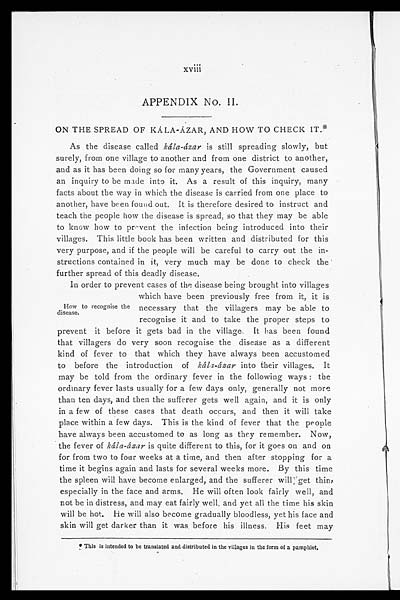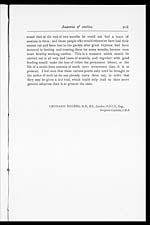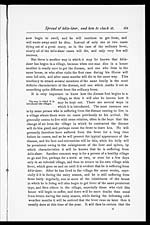Medicine - Institutions > Army health reports and medical documents > Report of an investigation of the epidemic of malarial fever in Assam, or, kala-azar > Appendix No. 2 - On the spread of kala-azar, and how to check it
(272) Page xviii
Download files
Individual page:
Thumbnail gallery: Grid view | List view

xviii
APPENDIX NO. II.
ON THE SPREAD OF KÁLA-ÁZAR, AND HOW TO CHECK IT.*
As the disease called kála-ázar is still spreading slowly, but
surely, from one village to another and from one district to another,
and as it has been doing so for many years, the Government caused
an inquiry to be made into it. As a result of this inquiry, many
facts about the way in which the disease is carried from one place to
another, have been found out. It is therefore desired to instruct and
teach the people how the disease is spread, so that they may be able
to know how to prevent the infection being introduced into their
villages. This little book has been written and distributed for this
very purpose, and if the people will be careful to carry out the in-
structions contained in it, very much may be done to check the
further spread of this deadly disease.
How to recognise the
disease.
In order to prevent cases of the disease being brought into villages
which have been previously free from it, it is
necessary that the villagers may be able to
recognise it and to take the proper steps to
prevent it before it gets bad in the village. It has been found
that villagers do very soon recognise the disease as a different
kind of fever to that which they have always been accustomed
to before the introduction of kálá-ázar into their villages. It
may be told from the ordinary fever in the following ways: the
ordinary fever lasts usually for a few days only, generally not more
than ten days, and then the sufferer gets well again, and it is only
in a few of these cases that death occurs, and then it will take
place within a few days. This is the kind of fever that the people
have always been accustomed to as long as they remember. Now,
the fever of kálá-ázar is quite different to this, for it goes on and on
for from two to four weeks at a time, and then after stopping for a
time it begins again and lasts for several weeks more. By this time
the spleen will have become enlarged, and the sufferer will get thin,
especially in the face and arms. He will often look fairly well, and
not be in distress, and may eat fairly well, and yet all the time his skin
will be hot. He will also become gradually bloodless, yet his face and
skin will get darker than it was before his illness. His feet may
*This is intended to be translated and distributed in the villages in the form of a pamphlet.
Set display mode to: Large image | Zoom image | Transcription
Images and transcriptions on this page, including medium image downloads, may be used under the Creative Commons Attribution 4.0 International Licence unless otherwise stated. ![]()
| Permanent URL | https://digital.nls.uk/75015116 |
|---|




